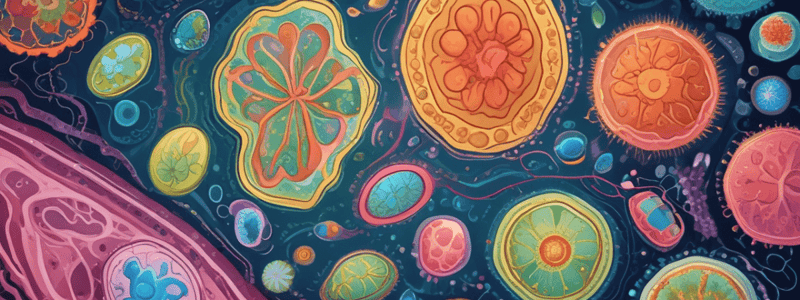Podcast
Questions and Answers
What is the primary function of the ER in most eukaryotic cells?
What is the primary function of the ER in most eukaryotic cells?
- To sequester Ca2+ from the cytosol (correct)
- To synthesize proteins
- To regulate cell growth
- To store genetic information
What happens to the signal sequence after it serves its function?
What happens to the signal sequence after it serves its function?
- It is translated into a functional protein
- It is embedded in the ER membrane
- It is transported to the Golgi apparatus
- It is cleaved off by a signal peptidase (correct)
What is the function of the Signal-Recognition Particle (SRP)?
What is the function of the Signal-Recognition Particle (SRP)?
- To translate mRNA into protein
- To direct proteins to the Golgi apparatus
- To recognize the ER signal sequence (correct)
- To regulate gene expression
What is the name of the organelle that the ER is in close contact with to regulate phosphoinositide levels?
What is the name of the organelle that the ER is in close contact with to regulate phosphoinositide levels?
What is the term for the sequence of amino acids that directs a protein to the ER?
What is the term for the sequence of amino acids that directs a protein to the ER?
What is the name of the receptor that the SRP guides the signal sequence to?
What is the name of the receptor that the SRP guides the signal sequence to?
What is the type of ER involved in transporting newly synthesized proteins and lipids?
What is the type of ER involved in transporting newly synthesized proteins and lipids?
What is the term for the process by which the signal sequence is removed?
What is the term for the process by which the signal sequence is removed?
What is the structure of SRP in animal cells?
What is the structure of SRP in animal cells?
What is the purpose of SRP binding to the signal sequence?
What is the purpose of SRP binding to the signal sequence?
Where does SRP bind to the ribosomal subunit?
Where does SRP bind to the ribosomal subunit?
What is the role of the SRP receptor?
What is the role of the SRP receptor?
What happens to the part of SRP bound near the ribosomal tunnel during protein translocation?
What happens to the part of SRP bound near the ribosomal tunnel during protein translocation?
What is the function of the translocator?
What is the function of the translocator?
What is the characteristic of membrane-bound ribosomes?
What is the characteristic of membrane-bound ribosomes?
What is the result of SRP binding to the signal sequence on protein synthesis?
What is the result of SRP binding to the signal sequence on protein synthesis?
What is the purpose of ER tubes and sheets?
What is the purpose of ER tubes and sheets?
What is the main difference between signal sequence and batch sequence?
What is the main difference between signal sequence and batch sequence?
Where are the linear signal sequences for protein translocation often found?
Where are the linear signal sequences for protein translocation often found?
What happens to the N-terminal signal sequences once the sorting process is complete?
What happens to the N-terminal signal sequences once the sorting process is complete?
What is characteristic of the signal sequence for protein import into the nucleus?
What is characteristic of the signal sequence for protein import into the nucleus?
What is the characteristic of the signal sequence for proteins destined for peroxisomes?
What is the characteristic of the signal sequence for proteins destined for peroxisomes?
What is the approximate percentage of the total membrane of an average animal cell that is constituted by the ER membrane?
What is the approximate percentage of the total membrane of an average animal cell that is constituted by the ER membrane?
What is the organization of the ER?
What is the organization of the ER?
What is the role of the SRP and SRP receptor in co-translational translocation?
What is the role of the SRP and SRP receptor in co-translational translocation?
What is the function of the Sec62–Sec63 complex in post-translational translocation in eukaryotic cells?
What is the function of the Sec62–Sec63 complex in post-translational translocation in eukaryotic cells?
What is the role of the SecA ATPase in post-translational translocation in bacteria?
What is the role of the SecA ATPase in post-translational translocation in bacteria?
What is the driving force for protein import after a precursor has initially inserted into the Sec61 translocator?
What is the driving force for protein import after a precursor has initially inserted into the Sec61 translocator?
What is the function of BiP molecules in post-translational translocation in eukaryotic cells?
What is the function of BiP molecules in post-translational translocation in eukaryotic cells?
Where is the SecA ATPase found?
Where is the SecA ATPase found?
What is the primary function of the cytosol in eukaryotic cells?
What is the primary function of the cytosol in eukaryotic cells?
What is the main function of the rough ER in eukaryotic cells?
What is the main function of the rough ER in eukaryotic cells?
What is the function of the Golgi apparatus in eukaryotic cells?
What is the function of the Golgi apparatus in eukaryotic cells?
What is the function of lysosomes in eukaryotic cells?
What is the function of lysosomes in eukaryotic cells?
What determines the final location of a protein in a eukaryotic cell?
What determines the final location of a protein in a eukaryotic cell?
What is responsible for recognizing sorting signals in proteins?
What is responsible for recognizing sorting signals in proteins?
What happens to proteins that do not have any sorting signals?
What happens to proteins that do not have any sorting signals?
Which organelles are responsible for generating most of the ATP in eukaryotic cells?
Which organelles are responsible for generating most of the ATP in eukaryotic cells?
Flashcards are hidden until you start studying
Study Notes
Eukaryotic Cell Structure and Function
- The nucleus contains the genome and is surrounded by cytoplasm, which consists of cytosol and cytoplasmic organelles.
- The cytosol is the main site of protein synthesis and degradation, accounting for more than half of the cell's total volume.
- The endoplasmic reticulum (ER) performs most of the cell's intermediary metabolism, with about half of the total membrane area in a eukaryotic cell enclosing the ER's labyrinthine spaces.
Organelle Functions
- The Golgi apparatus receives lipids and proteins from the ER and dispatches them to various destinations, often covalently modifying them en route.
- Lysosomes contain digestive enzymes that degrade defunct intracellular organelles.
- Mitochondria and chloroplasts generate most of the ATP used by cells to drive reactions requiring an input of free energy.
- Peroxisomes are small vesicular compartments that contain enzymes used in various oxidative reactions.
Protein Sorting and Transport
- Nearly all proteins, except those inside mitochondria and plastids, begin their synthesis on ribosomes in the cytosol.
- The final location of each protein depends on its amino acid sequence, which can contain one or more sorting signals that direct its delivery to different parts of the cell.
- Sorting signals are recognized by complementary sorting receptors that mediate movement between compartments.
- Proteins that do not have any sorting signals remain in the cytosol as permanent residents.
Signal Sequences and Sorting Receptors
- Signal sequences are usually composed of amino acid side chains and come in two general varieties: signal patch and signal sequence.
- Signal sequences direct proteins to different intracellular locations, such as the ER, mitochondria, nucleus, and peroxisomes.
- The signal for protein import into the nucleus is composed primarily of positively charged amino acids.
- A sorting signal for any particular destination needs to be sufficiently distinctive from all other sequences to permit its selective recognition by the appropriate sorting receptor.
Endoplasmic Reticulum (ER)
- The ER membrane typically constitutes more than half of the total membrane in an average animal cell.
- The ER is organized into a netlike labyrinth of branching tubules and flattened sacs that extend throughout the cytosol.
- The ER is specialized in regions that make intimate contacts with other organelles, such as mitochondria, plastids, endosomes, and the plasma membrane.
- The ER can sequester Ca2+ from the cytosol, and its release and reuptake occur in many rapid responses to extracellular signals.
Signal Sequence Discovery
- Signal sequences were discovered in secreted water-soluble proteins that are first translocated across the ER membrane.
- The signal hypothesis was formulated to explain these observations, proposing that the mRNA for the secretory protein codes for a protein that is bigger than the protein that is eventually secreted.
Signal-Recognition Particle (SRP) and Protein Translocation
- The ER signal sequence is guided to the ER membrane by the SRP, which binds to the signal sequence, and an SRP receptor in the ER membrane.
- SRP is a large complex that consists of six different polypeptide chains bound to a single RNA molecule in animal cells.
- The SRP exposes a binding site for an SRP receptor, which brings the SRP-ribosome complex to an unoccupied protein translocator in the ER membrane.
- The translocator transfers the growing polypeptide chain across the membrane, and SRP and SRP receptor are then released, allowing protein synthesis to resume at full speed.
Studying That Suits You
Use AI to generate personalized quizzes and flashcards to suit your learning preferences.





